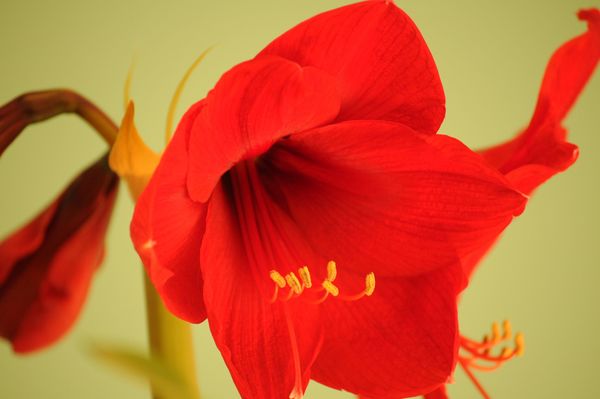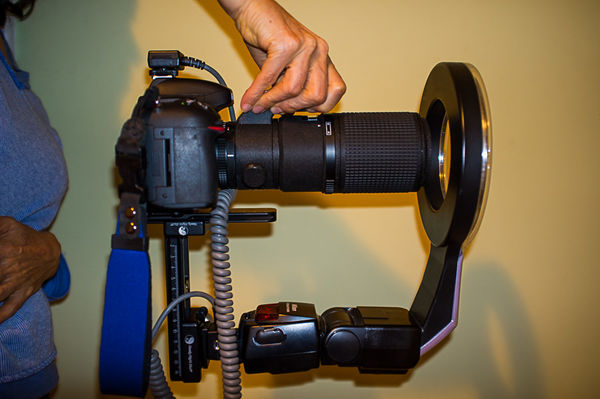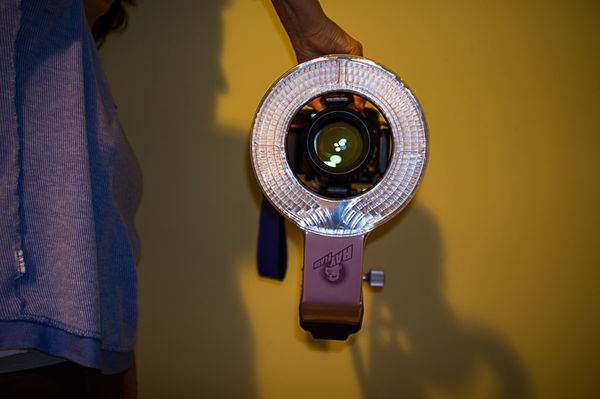Camera mounted light for macro
Apr 9, 2020 10:58:47 #
I've done a bit of research on doing macro photography and I'm looking for recommendations for camera mounted lights. Prefer something I can get used from KEH if possible.
So far I have the following (or coming in the mail);
Camera; Nikon D300
Lenses; 135 f3.5 and 200 f3.8 (both in M42 mount with adapter for the D300) I was looking at buying either an 85 mm or 105mm with macro capability but I was surprised to find that Ken Rockwell recommends a 200mm for macro. With that in mind I figured I could start with the two thrift store lenses I already own and use an extension bellows (had an extension ring get stuck on my Pentax and shied away from them, hence the bellows)
Extension bellows (coming)
Tripod
Most of what I want to do right off is get some good pics of my wife's amaryllis flowers and her other plants. the image attached was taken with my 55-200 Nikon w/VR hand held.
So far I have the following (or coming in the mail);
Camera; Nikon D300
Lenses; 135 f3.5 and 200 f3.8 (both in M42 mount with adapter for the D300) I was looking at buying either an 85 mm or 105mm with macro capability but I was surprised to find that Ken Rockwell recommends a 200mm for macro. With that in mind I figured I could start with the two thrift store lenses I already own and use an extension bellows (had an extension ring get stuck on my Pentax and shied away from them, hence the bellows)
Extension bellows (coming)
Tripod
Most of what I want to do right off is get some good pics of my wife's amaryllis flowers and her other plants. the image attached was taken with my 55-200 Nikon w/VR hand held.
Apr 9, 2020 11:03:58 #
The 200 macro is mainly for insects like butterflies that get spooked by shorter lenses. A 105 should be fine for flowers, as they don't get spooked quite so easily. Also, when shooting flowers, select "neutral" rather than "Vivid" or "Enhanced" so you get a more natural look.
Apr 9, 2020 11:10:08 #
Are you looking for a speedlight.......ring flash.......as any flash will work.......or are you wanting a continuous light......LED maybe?
Apr 9, 2020 11:14:40 #
I think Rockwell's endorsement of the 200mm Micro is a little out of date. I have three of the lenses and don't use them anymore. I have come to rely on the 105mm plus 1.4 Telextender (150mm in Full frame). The 200mm is still great artistically for smoothing out foregrounds and backgrounds in camera but that can be done in post which was impossible in film days.
Apr 9, 2020 11:19:21 #
Photosbytw, A video I watched showed how a light mounted on the flash fitting wasn't able to light the subject properly and how a homemade gooseneck (for lack of a better term) could be set up to get the light on the subject.
For starters I thought I can jury rig a couple of LED flashlights. So the answer to your question is yes, I just don't know which one. :-}
Rick
For starters I thought I can jury rig a couple of LED flashlights. So the answer to your question is yes, I just don't know which one. :-}
Rick
Apr 9, 2020 12:17:03 #
lsaguy wrote:
Photosbytw, A video I watched showed how a light mounted on the flash fitting wasn't able to light the subject properly and how a homemade gooseneck (for lack of a better term) could be set up to get the light on the subject.
For starters I thought I can jury rig a couple of LED flashlights. So the answer to your question is yes, I just don't know which one. :-}
Rick
For starters I thought I can jury rig a couple of LED flashlights. So the answer to your question is yes, I just don't know which one. :-}
Rick
An LED ring light is fairly inexpensive on the low end. Under $30. See https://www.bhphotovideo.com/c/product/1341881-REG/godox_ring48_ring_48_macro_ring.html
Apr 9, 2020 12:32:30 #
lsaguy wrote:
I've done a bit of research on doing macro photogr... (show quote)
I use reflectors on a speed light made from a white opaque beach bottle . The curved edges reflect the light downward and I control distance with the angle of the head. It cost nothing but a few minutes of time.
Apr 9, 2020 12:36:03 #
joer wrote:
I use reflectors on a speed light made from a white opaque beach bottle . The curved edges reflect the light downward and I control distance with the angle of the head. It cost nothing but a few minutes of time.
Did you mean "bleach" bottle? I tried that, but could only drink half the bottle before I got sick.

Apr 9, 2020 12:44:05 #
lsaguy wrote:
Photosbytw, A video I watched showed how a light mounted on the flash fitting wasn't able to light the subject properly and how a homemade gooseneck (for lack of a better term) could be set up to get the light on the subject.
For starters I thought I can jury rig a couple of LED flashlights. So the answer to your question is yes, I just don't know which one. :-}
Rick
For starters I thought I can jury rig a couple of LED flashlights. So the answer to your question is yes, I just don't know which one. :-}
Rick
Rick,
Most anything will work. Some are better than others. It just depends the magnification you wish to use. That said, you must take into consideration the diffusing the light which is necessary to controlling it.......LED flashlights are fine just be sure to use one with a high luminosity as lighting your subjects can be difficult at times. As for your "homemade gooseneck" is concerned. I don't remember how many Pringles cans I sacrificed to use on my speedlites. They're great.......because they will fit and remain in place on the speedlght. The interior of the can is lined with a metallic like finish which prevents most of the light from bring lost. Gluing, taping or stapling diffusion material is easy......If you destroy the can or alter it so many time to suit your needs that it becomes unusable...........Buy another can of Pringles........
Use youtube........enter "using pringles can for flash".........it should give a few videos on how to build one
Apr 9, 2020 14:52:16 #
flyboy61
Loc: The Great American Desert
If you want to use flash, this simple rig has worked well for me. Camera on TTL, TTL flash mounted in camera's hot shoe, bounce reflector on flash, tilted forward at 60-75 degrees, Diffuse light covers from very close to the lens to reasonable distances in front. Works with various lenses. Cheap, simple, reliable! Off camera with a sync cord works fine, too! 

Apr 9, 2020 19:51:35 #
lsaguy wrote:
I've done a bit of research on doing macro photogr... (show quote)
Why limit yourself to that, off-camera lights/flash are/ is always preferable and sooo much more flexible/convenient?
Apr 9, 2020 22:10:37 #
RWR
Loc: La Mesa, CA
lsaguy wrote:
I've done a bit of research on doing macro photogr... (show quote)
For nature closeups and macro work, I prefer directional side lighting to enhance textures, so I try to avoid frontal lighting. I use shorter lenses so I can hold the light close to the subject while composing. That also means I don’t need much working distance, often 15mm is enough. The rectangular light panels of pocket work lights are ideal. I use Nebo Lil Larry and Big Larry2 LED lights, but this Big Larry PRO looks even better: https://www.nebotools.com/p/BIG-Larry-PRO/487
lsaguy wrote:
(had an extension ring get stuck on my Pentax and shied away from them, hence the bellows)
This makes no sense - the mounts are the same, so one is no less likely to get stuck than the other.
I’m sure you know that the correction lens in your adapter can be removed, in which case it is a short extension tube. I have a FotodioX M43-Nikon adapter. Factoring in the difference in flange focal distances, the effective extension is 5.28mm. For better IQ with magnifications greater than 1X, you might want to consider lens reversing, lens coupling, or enlarging lenses. Good luck, closeups and macro is very fascinating.
Apr 9, 2020 22:40:56 #
lsaguy wrote:
I've done a bit of research on doing macro photogr... (show quote)
Well, FWIW I have found the combination of the Nikkor 200MM Micro lens with a Ray-Flash ring light attached to my SB-800 flash as it affords me good working distance plus enough illumination that I can use small apertures for max DOF. When I walk through a botanical garden I get a lot of strange looks (and some folks approach me) but the results please me at least. Most of the shots in the "Flora" gallery in my website (see my signature below) were taken using this combination; a few were taken with the Fuji 80MM macro lens and a Godox shoe-mounted flash, but the superior OVF in the DSLR makes it easier to grab shots as I see them - no tripods (and Wimberly "plamps" to hold flowers still).
Attached are some pics of the rig - since the 200MM is so long I have a few components from RRS that enables me to mount the flash beneath the camera and have the Ray-flash held in front of the lens. On the Fuji, with the (shorter) 80MM, I use the more conventional approach of having the flash in the hot shoe and the Ray-flash in its intended position.
Apr 9, 2020 23:00:46 #
Here is a nice article with lots of Macro calculators. To use extension you take the extension length in mm and divide by the lens focal length, then add back any native magnification the lens originally had. So to use a 200mm lens at 1:1 magnification you need 200 mm of extension. Thats going on 8 inches. This will make the aperture 2 stops darker. So a ring flash can be useful.
https://www.cambridgeincolour.com/tutorials/macro-lenses.htm
https://www.cambridgeincolour.com/tutorials/macro-extension-tubes-closeup.htm
https://www.cambridgeincolour.com/tutorials/macro-lenses.htm
https://www.cambridgeincolour.com/tutorials/macro-extension-tubes-closeup.htm
Apr 10, 2020 00:05:05 #
bleirer wrote:
Here is a nice article with lots of Macro calculat... (show quote)
Understand that the 200MM Micro Nikkor goes down to 1:1 without extension tubes, so it depends on the design of the lens as well as the simple focal length.
If you want to reply, then register here. Registration is free and your account is created instantly, so you can post right away.








